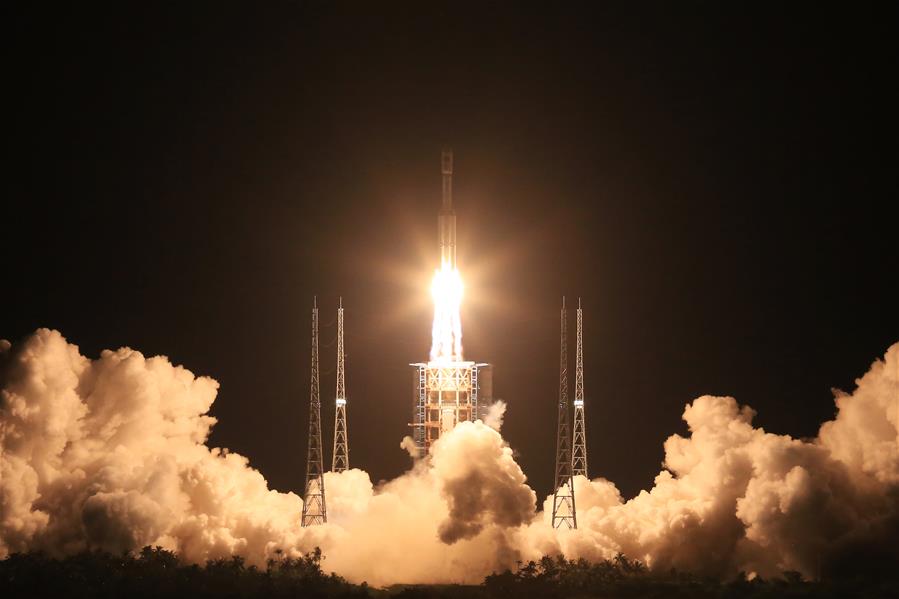China launches new generation carrier rocket
 0 Comment(s)
0 Comment(s) Print
Print E-mail Xinhua, June 25, 2016
E-mail Xinhua, June 25, 2016
|
|
| A Long March-7 carrier rocket lifts off from Wenchang Satellite Launch Center, south China's Hainan Province, June 25, 2016. (Xinhua/Li Gang) |
China on Saturday successfully blasted off its new generation carrier rocket Long March-7 from a new space launch center in Wenchang, Hainan province.
In a cloud of white smoke, the rocket, carrying a scaled-down version of "a reentry module of a multi-function spacecraft," ascended against a the dark sky, trailing a vast column of flame.
Minutes later, Wang Hongyao, deputy chief commander of the mission, declared the launch a success.
He said the rocket's payload, including the reentry module, separated from the rocket 603 seconds after blast-off, and entered an oval orbit with a low point, or perigee, of 200 kilometers, and a high point, or apogee, of 394 kilometers.
The re-entry module is expected to return to Earth on Sunday afternoon, after orbiting the Earth for 13 times. It is expected to land in a desert in China's Inner Mongolia Autonomous Region, close to the Jiuquan Satellite Launch Center.
The Long March-7 is a medium-sized, two-stage rocket that can carry up to 13.5 tonnes to low-Earth orbit (LEO).
Experts say the 53.1-meter-long, 597-tonne rocket will become the main carrier for China's future space missions.
Earlier reports said the rocket now uses kerosene and liquid oxygen as fuel, rather than the highly toxic propellant, making it more environmental friendly and less expensive.
Saturday's launch is the first by the Wenchang site, and the 230th of China's Long March carrier rocket family.
Its mission is to verify the design and performance of the new carrier rocket, to evaluate mission execution capacity of the Wenchang launch site, and to check coordination and compatibility of project-related systems.
The Long March-7's 13.5-tonne LEO payload capacity means it can carry 1.5 times as much as the country's current launch vehicles. "The more our rockets can lift, the farther we can venture into space," said Ma Zhonghui, chief designer for the rocket.
"Long March-7's successful maiden flight will greatly lift up China's comprehensive space capacity, and give the country a hefty boost in building itself into a space power," he said.
The launch success also marks a key step towards China's plans to eventually operate a permanent space station in the final step of the country's three-phase manned space program.
The country launched its first manned spaceflight in 2003, and blasted off its first space lab Tiangong-1 in 2011.
The next and final step will be to assemble and operate a 60-tonne space station around 2022.
To do that, Chinese engineers have planned four space launches within ten months till April next year, of which the Long March-7 mission is the first.
A second mission in late September will put the Tiangong-2 space lab into orbit, and the third one will see the Shenzhou-11 spacecraft, which will carry two Taikonauts, dock with Tiangong-2 in November.
In April 2017, the country's first cargo ship Tianzhou-1, which literally means "heavenly vessel," will be sent to dock with Tiangong-2 in the final mission.
Wenchang will be the main launch site for future space station missions.
Completed in 2014, the Wenchang launch site is the the fourth of its kind in China.
Among the other three, Jiuquan Satellite Launch Center in the Gobi Dessert is currently the nation's only manned spacecraft launch center, while Xichang in southwest China's Sichuan Province is mainly used to launch powerful-thrust rockets and geostationary satellites.
The third, Taiyuan Satellite Launch Center in north China's Shanxi Province, is capable of launching satellites into both medium and low orbits.
Being the closest site to the equator, Wenchang boasts considerable latitudinal advantages - Satellites launched from low latitudes are expected to have a longer service life as a result of the fuel saved by a shorter maneuver from transit to geosynchronous orbit. That extra fuel can later be used to regulate and sustain orbit.
This means rockets launched in Wenchang will allow their payload to be increased by more than 300 kg, 7.4 percent more than from any of the other three centers. That translates into a saving of 6 million U.S. dollars each launch.







Go to Forum >>0 Comment(s)